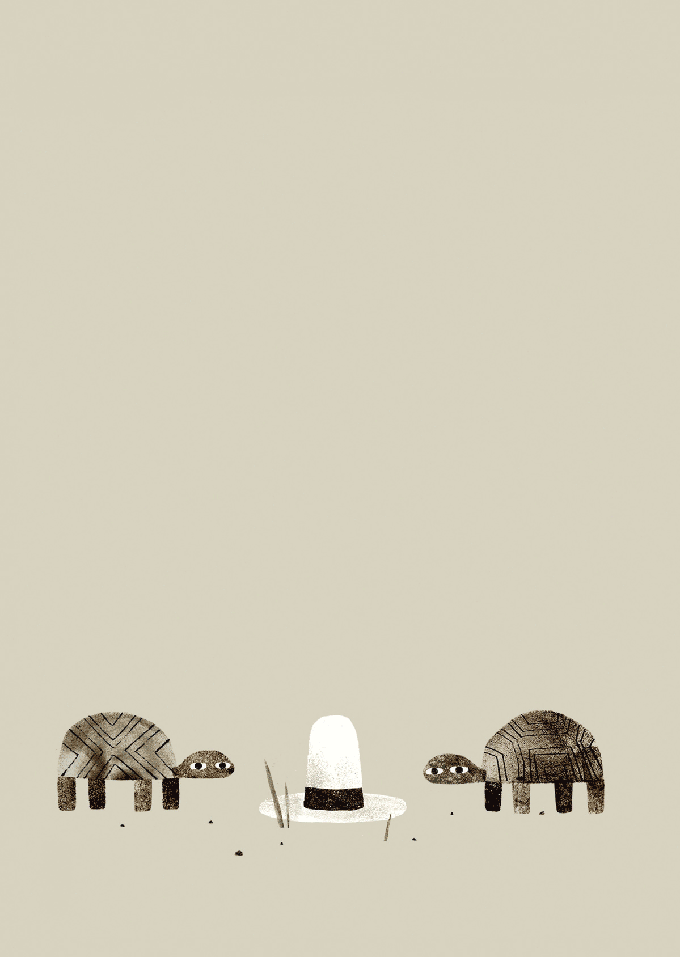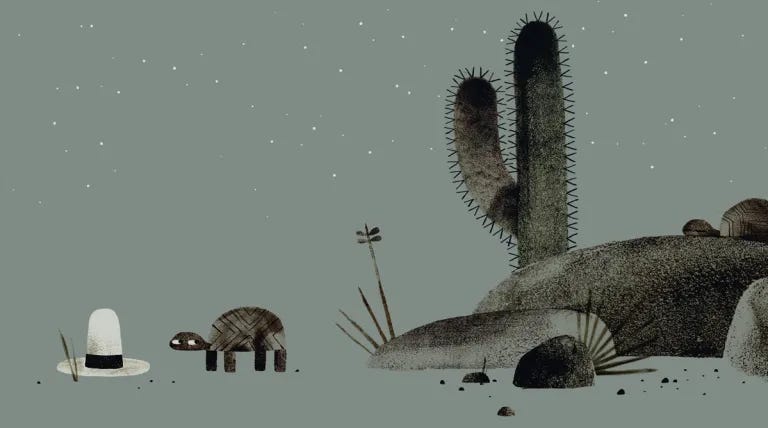Children's books and creativity - part two
What we can learn about the creative process from Jon Klassen's We Found A Hat
I've lost count of how many times I've come up with an idea that sounds amazing in my head and looks strong written down - only for it to fall apart the first time I try to explain it to somebody verbally.
Something about pitching an idea, even to a trusted colleague at an embryonic stage, forces you to see the idea in its most authentic state.
And sometimes, that means the end of the idea and going back to the drawing board. And sometimes, it creates something that still works, even if it lacks the purity of your original thought.
calls this "the less good idea" - a concept he sourced via The Centre for the Less Good Idea, an "interdisciplinary incubator space" based in Johannesburg.The Centre describes the process I just outlined beautifully:
"Often, you start with a good idea; it might seem crystal clear at first, but when you take it off the proverbial drawing board, cracks and fissures emerge in its surface, and they cannot be ignored. It is in following the secondary ideas, those less good ideas coined to address the first idea's cracks, that the Centre nurtures, arguing that in the act of playing with an idea, you can recognise those things you didn't know in advance but knew somewhere inside of you."
Coming to terms with the less good idea is crucial for the creative process. If you try too hard to hold on to the image of the crystal clear idea, you'll invariably end up with something that looks good on paper but needs more substance. Ideas that work on a slide but need more energy to make it in a campaign.
I think this point is beautifully illustrated by Jon Klassen's We Found A Hat. Regular readers will know my daughter loves the first book in Klassen's "Hat trilogy" (I Want My Hat Back). Well, she bought me We Found A Hat for Christmas, another book from that series, so we could enjoy it together (and also so that I had some inspiration for a new post).
I know plenty of my LinkedIn network are Klassen fans, but if you're not familiar with We Found A Hat, it's a story in three parts - two tortoises find a hat; they agree they both look good in said hat, but there is only one hat. So they mutually decide to leave it behind and go on their way. But one tortoise continues to pine for the hat - parts two and three cover tortoise two’s gradual acceptance that this is not the hat for them.
When reading We Found A Hat to Ivy, I started thinking of the hat (and it is a lovely hat) as a creative idea.
Coming up with a big creative idea often feels like a voyage of discovery - after hours/days/weeks of work, you come across the perfect answer, almost fully formed. At that moment, everything about the idea is perfect. Like the tortoise's hat, you feel like it was made for you.
But as you remove the idea from the proverbial drawing board to use the Centre for the Less Good Idea's phrase, the challenges with that idea become all too clear. For the two tortoises in We Found A Hat, it's a simple challenge - there's only one hat, but there are two of them. In our world, it's not always easy to see the challenge, let alone accept it.
The most common challenges I've come across in the past include - you've got an excellent name for an idea, but the execution doesn't live up to the promise of the name (particularly challenging if one person came up with the name and is unable to let it go). Increasingly also common is that your idea works well for curated and controlled channels (our term at Teneo for owned and paid) but lacks a news angle that will generate media coverage. It might also be a BIG idea that your client can't afford. Or an idea that's perfect for one audience but needs more relevance for another. Or it's too British when your brief is global. I'm sure you've got your own scenarios.
In We Found A Hat, the two tortoises diverge in their willingness to accept they can't hold on to the hat. One tortoise continually pines for the hat that couldn't be; the other moves on swiftly.
Acceptance only comes to both tortoises in the final act of the book. Tortoise one dreams that they both have hats, always thinking of the two of them together. This act of selfless dreaming finally convinces tortoise two to give up on the hat.
Like many a creative process, it takes time for tortoise two to give up on the original idea of the hat. Its pull is strong - particularly given the lack of initial obvious hat solutions for the two tortoises.
It's hard work to carve out that less good idea, to take the original concept and transform it into a coherent, integrated campaign. Some people find themselves continually harking back to the original but ill-fitting idea. Acceptance is vital, both for hats and creative ideas.
Sometimes, you must give up on that great name to make the campaign work. Sometimes you must accept a retro-fitted insight to make the deck flow and the campaign sing. Sometimes there just isn’t enough budget to go around - so come to peace with your compromises. As Rob Estreitinho, author of
often says, "better beats best".Don't hold on to that unattainable hat - let that idea go and accept the less good idea. It doesn't mean it will lack effectiveness or impact just because it doesn't match the image you head in your head. The best campaigns rarely do.





